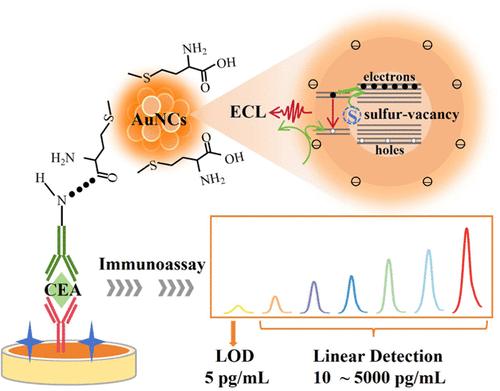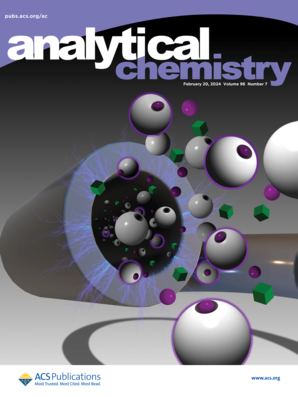Endogenous Free-Electron-Involved Coreactant-Free Electrochemiluminescence from Nanoclusters and Its Immunoassay Application
IF 6.7
1区 化学
Q1 CHEMISTRY, ANALYTICAL
引用次数: 0
Abstract
All of the commercialized electrochemiluminescence (ECL) immunoassays are automatically conducted at +1.40 V (vs Ag/AgCl) in the coreactant route. To alleviate the exogenous effect of coreactants and simplify the operation procedures, herein, a sulfur-vacancy-involved and free electron strategy is proposed to exploit Au nanoclusters (NCs) as anodic electrochemiluminophores and perform a coreactant-free immunoassay. The deficient coordination between the sulfhydryl of Met and the Au core might induce the departure of partial S atoms and enable Met-capped AuNCs (Met-AuNCs) with a sulfur-vacancy-involved electron-rich nature. The electron-rich nature tends to endow Met-AuNCs with unpaired endogenous free electrons, which can directly combine exogenous holes for light emitting. Coreactant-free ECL at around +0.86 V is consequently and conveniently achieved by merely oxidizing Met-AuNCs at the anode. The coreactant-free ECL is qualified to determine human carcinoembryonic antigen from 10 to 5000 pg/mL with a limit of detection of 5 pg/mL. Electron paramagnetic resonance provides clear evidence that endogenous free electrons within Met-AuNCs play an important role in the generation of coreactant-free ECL. This sulfur-vacancy-involved and free electron strategy is promising for designing nanoelectrochemiluminophores with improved immunoassay performance.

求助全文
约1分钟内获得全文
求助全文
来源期刊

Analytical Chemistry
化学-分析化学
CiteScore
12.10
自引率
12.20%
发文量
1949
审稿时长
1.4 months
期刊介绍:
Analytical Chemistry, a peer-reviewed research journal, focuses on disseminating new and original knowledge across all branches of analytical chemistry. Fundamental articles may explore general principles of chemical measurement science and need not directly address existing or potential analytical methodology. They can be entirely theoretical or report experimental results. Contributions may cover various phases of analytical operations, including sampling, bioanalysis, electrochemistry, mass spectrometry, microscale and nanoscale systems, environmental analysis, separations, spectroscopy, chemical reactions and selectivity, instrumentation, imaging, surface analysis, and data processing. Papers discussing known analytical methods should present a significant, original application of the method, a notable improvement, or results on an important analyte.
 求助内容:
求助内容: 应助结果提醒方式:
应助结果提醒方式:


